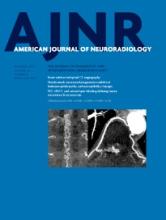Article Figures & Data
Tables
Characteristics IPH/Subtotal OR P Value Sex Male 2.5% (4/161) Ref Female 2.5% (16/632) 1.02 (0.34–3.09) .97 Hypertension Yes 5.2% (13/249) 2.45 (0.96–6.23) .06 No 2.2% (7/318) Ref Controlled hypertension Yes 5.8% (12/206) 0.58 (0.02–15.92) .75 No 0.0% (0/4) Ref Current smoker Yes 3.2% (3/94) 1.32 (0.38–4.60) .66 No 2.4% (17/699) Ref Aneurysm location Posterior circulation 2.2% (2/89) Ref Anterior circulation 2.6% (18/704) 1.14 (0.26–5.00) .86 Aneurysm location by vessel Internal carotid artery 2.4% (14/590) Ref PcomA 3.8% (2/53) 1.61 (0.36–7.30) .78 ACA 25.0% (2/8) 13.71 (2.54–74.02) .01 Basilar artery 2.3% (1/43) 0.98 (0.13–7.63) .43 Vertebral artery 3.0% (1/33) 1.29 (0.16–10.09) .63 Rupture status Unruptured 1.9% (14/719) Ref Ruptured 8.1% (6/74) 4.44 (1.65–11.94) .00 Aneurysm type Saccular 2.0% (12/600) Ref Fusiform 3.9% (4/102) 1.92 (0.42–8.82) .91 Dissecting 3.8% (2/53) 2.00 (0.63–6.33) .82 Other 5.3% (2/38) 2.72 (0.59–12.63) .48 Aneurysm size <10 mm 1.6% (6/387) Ref 10–24.9 mm 3.3% (11/338) 2.14 (0.78–5.84) .70 ≥25 mm 4.8% (3/63) 3.18 (0.77–13.04) .23 Note:—PcomA indicates posterior communicating artery; ACA, anterior cerebral artery; Ref, reference.
Characteristics IPH/Subtotala OR P Value Preprocedural antiplatelet use Yes 2.5% (17/681) 0.93 (0.27–3.23) .91 No 2.7% (3/112) Ref Preprocedural platelet aggregation studies Yes 2.5% (14/564) 0.95 (0.36–2.49) .91 No 2.6% (6/229) Ref Heparin administration Yes 2.6% (18/704) 1.14 (0.26–5.00) .86 No 2.2% (2/89) Ref Reversal of heparin Yes 5.6% (1/18) 2.33 (0.29–18.49) .43 No 2.5% (17/689) Ref No. of PEDs used 1 1.7% (9/533) Ref 2 3.3% (6/183) 1.97 (0.69–5.62) .96 3+ 6.6% (5/76) 4.10 (1.34–12.58) .04 How multiple PEDs were used Overlapping 1.4% (2/140) Ref Multiple layers 7.5% (3/40) 5.59 (0.90–34.72) .96 Additional length 7.9% (6/76) 5.91 (1.16–30.06) .96 Multiple layers and overlapping 0.0% (0/2) NA Sheaths used Medical Arrow-Flexb Yes 0.0% (0/35) NA No 3.5% (19/546) Medical Shuttle Select Yes 3.2% (8/249) 0.97 (0.38–2.45) .95 No 3.3% (11/332) Ref Pinnacle Destinationc Yes 5.9% (2/34) 1.95 (0.43–8.80) .39 No 3.1% (17/547) Ref Microcatheter used Marksmand Yes 3.2% (18/557) 0.77 (0.10–6.00) .80 No 4.2% (1/24) Ref












